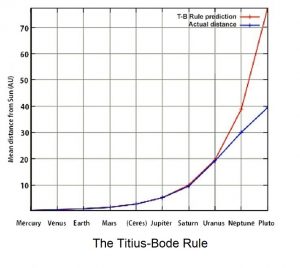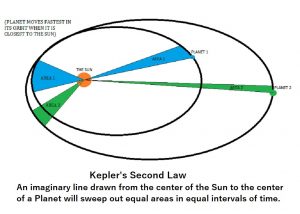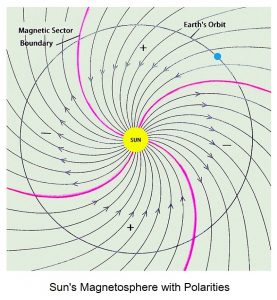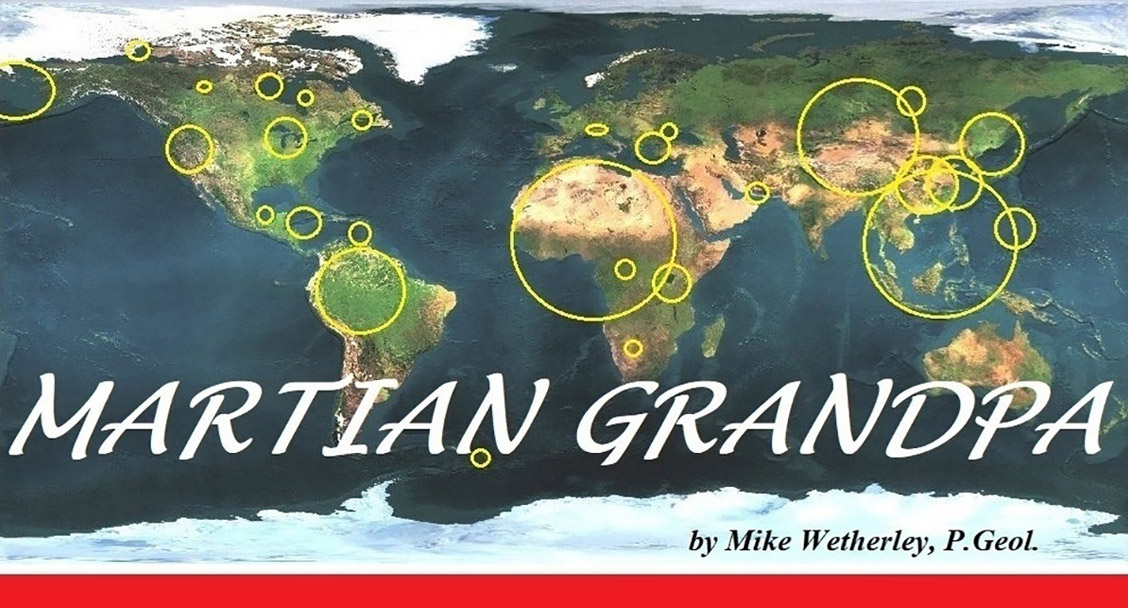CHAPTER 10
Venus
The retrograde rotation of Venus is explained by
Kepler’s Second Law.
 The Legend
The Legend
The ancient Greeks had a legend about the god Zeus swallowing the goddess Metis, who was pregnant. She gave birth to Athena, inside Zeus, who was seized by a raging headache. Hephaestus, the son of Zeus, split open Zeus’s skull with an axe and Athena sprang out of Zeus’s skull as an adult, clothed in a suit of shining armor. Athena, associated by the Greeks with the planet Venus, became their goddess of wisdom.
Even by the usual standards of Greek mythology, this story is bizarre. One might ask why it became established at all if there wasn’t some allegorical interpretation to it. There was!
Velikovsky
A theme running through the famous book ‘Worlds in Collision’ by Immanuel Velikovsky, published in 1950, is that Venus came out of Jupiter as a comet trailing a prominent tail, and later turned into a planet. Velikovsky was an outstanding scholar who, nonetheless, included enough mistaken conclusions in his writings that many scientists failed to take him seriously. This was regrettable because he discovered ancient sources, long forgotten, which could have changed the foundations of astronomy and geology. Most scientists still fail to appreciate the significance of his accomplishments.
Velikovsky was mistaken in accepting the legend about the origin of Venus so literally. His claim that Venus came out of Jupiter as a comet which changed into a planet could not be true and astronomers knew it. He quoted numerous historical records of Venus having been observed coming from Jupiter but it apparently didn’t occur to him that Venus could have been a former moon of Jupiter, and the scientists weren’t about to help him out.
 Galilean Orbits
Galilean Orbits
I am proposing that Venus was a moon of Jupiter until less than 4,000 years ago. It had been, in effect a fifth ‘Galilean’ moon. Jupiter’s four largest moons at present, progressing outward are Io, Europa, Ganymede, and Calisto, and the moon Ganymede is larger than the planet Mercury. They are known as the Galilean moons in honor of their discoverer, Galileo Galilei. Some scientists have claimed that the moons follow a principle called the Titius-Bode Rule and that all potential orbits from Io to Calisto are presently occupied. The rule describes how proceeding outward from the Sun, each planet is approximately twice as far from the Sun as the one before.
This ‘rule’ is something astronomers often discredit, but they still like to quote it when it suits them. The rule is absolutely real and is governed by the electromagnetic effect, but ‘fails’ ultimately with distance. Just because its influence does not extend to infinity does not make it any less a rule. The Titius-Bode Rule applies as far from the Sun as the planet Uranus before it breaks down for Neptune, although Pluto approximates the predicted position for the next planet out from Neptune.
There is another way of looking at this within the Jovian system. Astronomers have determined that the three inner Galilean moons are in orbital resonance with Jupiter. The result is that in the time it takes for Io to make four orbits around Jupiter, Europa makes two orbits and Ganymede makes one. One might suspect a presently unoccupied potential orbit since a moon between Io and Europa could have an orbital resonance of three. All four Galilean moons are tidally locked to Jupiter, presenting the same face, constantly to their planet. Venus is considerably hotter than Europa, with an interior that is cooler than that of Io, adding to the evidence that Venus once occupied an orbit between Io and Europa.
I support Velikovsky’s belief, not currently shared by most astronomers, that smaller worlds change their orbits from time to time and serve variously as planets or moons. There is not a shred of proof for astronomers’ claims that all planets and moons formed in their present orbits and have never left them. These claims directly contradict numerous ancient sources that Velikovsky identified, and are simply examples of notions that struck someone as a good idea at the time.
Volcanism
Io’s constant volcanism is commonly attributed to tidal heating as its interior is pulled by gravity between Jupiter and the other Galilean moons, although there is no proof of this either. Dr. Donald Scott (see below) has drawn attention to the fact volcanic centers on the surface of Io wander about, which is something that most volcanos simply don’t do. This activity is the result of electrical forces, rather than tidal attraction.
Volcanism on Venus may have been generated electrically while it was a moon of Jupiter and some volcanos appear to have moved along a circular path during their formation. Some that made less than a complete revolution formed horseshoe-shaped craters. The volcano ‘Buck’ on Venus is offered as an example of this phenomenon in ‘The Electric Sky’ (Page 138) by Dr. Donald Scott, a retired professor of electrical engineering and talented amateur astronomer. ‘The Electric Sky’, printed by Mikamar Publishing, is offered as “A Challenge to the Myths of Modern Astronomy”, and should be required reading for every astronomer.
It will not surprise my readers to learn that I do not accept every one of Dr. Scott’s conclusions. For example, I confidently attribute certain features in astronomy to distinctly different causes; such as Valles Marineris, the giant canyon on Mars (See: #12: Mars).
It could be preferable to train electrical engineers to become astronomers than to train astronomers to become electrical engineers. Be that as it may, while there is no recognized requirement for electrical engineers to become astronomers, the best thing that astronomers could do to further their understanding of the Universe would be to learn something about electrical engineering. Beliefs about our own Sun, stars, comets, our galaxy and the Universe itself too often attribute observed phenomena to gravity instead of to electromagnetism. (See: #14: The Electric Sun).
The Hot Surface
Venus has the highest average surface temperature of all the planets and moons in the Solar System, including Mercury, which is only half the distance of Venus from the Sun. The surface of Venus, at almost 500o C (almost 900o F), is hotter than any atmospheric effect could achieve. Russian probes descending on parachutes indicated rising temperatures as the surface was approached, and a NASA report on the fly-by of Mariner II in 1962 confirmed high surface temperatures, also concluding: “Little greenhouse effect could occur there”.
Heat flow measurements have demonstrated that heat flows upward to the surface of Venus. (That is what Velikovsky claimed also, although he claimed Venus had a high internal temperature because it had come out of Jupiter.) The extremely high surface temperature of Earth’s sister planet has been retained since it was a Jovian moon, being heated by Jupiter’s strong electrical field.
Carl Sagan described Jupiter as a “failed star” because he believed it to be made up primarily of hydrogen and helium. He also recognized that Jupiter must take in electrical energy from its surroundings, although he failed to recognize that our Sun takes in electrical energy from its surroundings as well, as the source of its energy. Sagan didn’t have the benefit of results from the Ulysses program, but observations derived from it have been ignored by astronomers in any case.
Ulysses had the greatest potential to change astronomy of any project that ESA-NASA has carried out, but the lessons that should have been learned were ignored due to an inability of scientists to think outside of their current orthodoxy. A Ulysses-type experiment would show that electric currents enter Jupiter’s north and south poles. For those of you who are unfamiliar with the Ulysses program, the following extract is taken from Chapter #14: The Electric Sun.
The “Ulysses” Program
The Ulysses program has always been of particular interest to me. In 1994 I accepted an invitation to present a paper to the Planetary Geology group at NASA’s Jet Propulsion Laboratory in Pasadena, which is NASA’s main research and data processing facility. There, I had the opportunity of discussing the Ulysses program with scientists who were directly involved in it.
Launched from the Space Shuttle ‘Discovery’ in October 1990, Ulysses is still the only space probe to have been sent outside the plane of the ecliptic. Since there wasn’t a rocket on Earth with the capability of accomplishing this feat, a unique solution was employed. Ulysses was directed to swing around Jupiter, employing that planet’s gravity field to bring its trajectory close to a right angle to the ecliptic plane. As Ulysses sped toward the Sun, crammed with magnetometers, spectrometers, charged particle detectors, radiometers, etc. it sure looked as if science was about to be carried out.
A discovery was soon made. As Ulysses made its first approach to the south pole of the Sun NASA reported electric currents in the “trillions” of amperes flowing out of the Sun. Their point might have been made even more effective if a term like “gazillions” had been employed. (A space probe cannot measure voltage directly but it can distinguish an electric field.) One problem was that Ulysses was unable to measure the absolute strength of those currents or, apparently, to interpret the direction of current flow.
These currents constituted the most important information to come out of the entire program, but NASA’s claim that they flowed out of the Sun was made with no supporting data. It was made to agree with the prevailing belief of astronomers. Eventually, though, NASA recognized that the direction of current flow was into the Sun.
Even so, a senior member of the Solar Group at JPL assured me (by personal e-mail) that when Ulysses arrived at the Sun’s north-pole the Sun would be in the opposite phase of its 11-year cycle and then the currents would be flowing out of the Sun. (This was notable since they almost never make predictions like that.) I wrote back to tell him that there was no way this would happen (I suppose I should have been more diplomatic). I did not receive a reply.
The Atmosphere of Venus
The temperature of the Venusian atmosphere changes very little between the night and day sides, and from pole to pole, despite the slow rotation of the planet and its negligible surface winds. In fact, the only notable temperature variation occurs with altitude as ‘snow’ precipitates on the mountain tops. This is not water-snow but a different white substance, probably crystallized carbon dioxide, that precipitates out of the atmosphere. Long, narrow lava flows, frequently exhibiting an anastomosing (recombining) pattern, are an indication they formed on a hot surface. The lava remained liquid longer than it would have on a cooler surface, flowing easily and forming complex braided patterns.
Venus appears to have had an ocean, resulting in the development of a deep regolith (soil and other unattached material). If the regolith developed when Venus was a Jovian moon, superheated water and steam would have enabled deep weathering of the basalt surface. Some of the basalt probably occurs as pillow lava, which would have formed just as it does in Hawaii when molten lava plunges into the sea. Mars appears destined to attract more interest by space agencies, however, so the pillow lavas will have to wait a while before being confirmed.
The Comet Tail
A comet from the Oort Cloud was perturbed into an orbit around Jupiter and encountered Venus. Due to their disparate electrical charges, a flow of electricity surged through the comet when it encountered the moon. The comet disintegrated and its electric charge was transferred to Venus, with two immediate results.
The finer portion of the regolith was repulsed away from Venus electrically while continuing to be attracted gravitationally, enveloped by a highly reflective sheath of ice from the comet. This constituted the “comet tail” referred to by Velikovsky. Venus was propelled rapidly away from Jupiter because its electric charge was now incompatible with the charge of Jupiter. Planet and moon each carried a negative electrical charge.
Comets are powerful electrical capacitors, storing huge amounts of electrical energy. Countless comets in the Oort Cloud constitute the cathode for the entire Galaxy. Comets are commonly claimed to have been ‘leftover’ from the formation of the Galaxy, but they are not leftover from anything. Comets constitute an essential part of a beautifully functioning system that has not yet been appreciated.
The surface of Venus has been described as “clean and pristine” by NASA, for only coarse gravel and boulders now remain upon its surface. According to Velikovsky, rusty soil from Venus which entered Earth’s atmosphere accounted for the first of the ten plagues recounted in the Book of Exodus in the Old Testament and gave the Red Sea its name. Velikovsky described two close encounters between Venus and Earth, 52 years apart. It was at the first encounter that the plagues and other events recounted in Exodus occurred, and the Mayans, and others retained the memory of this interval in their tablets and monuments.
It is interesting that no magnetic field is associated with Venus, while a magnetic field has been recognized for each of the Galilean moons. Astronomers have attributed this to electric currents being induced by Jupiter’s strong field, so Venus might also have had a magnetic field when it was a moon of Jupiter. As far as is known, all the planets and moons of the inner Solar System share similar crustal rock types, the most common being basalt.
Removal from Orbit
Venus was propelled rapidly away from Jupiter since the electrical charge it had acquired from the comet was too strong for it to continue in its accustomed orbit. Since Venus moved toward the inner Solar System it was required to move ahead of Jupiter. This is explained by Kepler’s Second Law, which describes how an imaginary line from any planet to the sun sweeps out equal areas of space in equal amounts of time.
 But Venus had a tidal lock on Jupiter, just as Earth’s moon has a tidal lock on Earth, always presenting its same face toward us. As Venus moved ahead of Jupiter it turned back, very slowly, continuing to face Jupiter. Distance eventually overcame this attraction, but even today Venus continues to rotate in a retrograde direction (opposite to that of the other planets), so slowly that on Venus, a day is longer than a year. One result of the retrograde rotation is that on Venus the Sun rises in the west and sets in the east. It is probable that most times a Galilean moon is displaced from its orbit around Jupiter it is propelled into the inner Solar System, due to the influence of the Sun.
But Venus had a tidal lock on Jupiter, just as Earth’s moon has a tidal lock on Earth, always presenting its same face toward us. As Venus moved ahead of Jupiter it turned back, very slowly, continuing to face Jupiter. Distance eventually overcame this attraction, but even today Venus continues to rotate in a retrograde direction (opposite to that of the other planets), so slowly that on Venus, a day is longer than a year. One result of the retrograde rotation is that on Venus the Sun rises in the west and sets in the east. It is probable that most times a Galilean moon is displaced from its orbit around Jupiter it is propelled into the inner Solar System, due to the influence of the Sun.
The retrograde rotation of Venus is claimed to be slowing down. If this is so, Venus could eventually develop a tidal lock on the Sun (a planet behaving like a moon). It used to be thought that Mercury behaved in such a manner but Mercury is now known to have an orbital resonance of 1 1/2 rotations to each orbit it makes of the Sun. On Mercury also, the Sun rises in the west and sets in the east. The orbit of Venus is the most circular of any planet, which could not have been attained in response to gravitational capture alone; electromagnetism clearly played a role. Venus, just like Mars, is known to have a phase lock on Earth so that it presents its same face to Earth at every closest approach.
One must now recognize the electrical reality of the Solar System, a reality promoted by the late Swedish Nobel laureate Hannes Alfvén, the late Ralph E. Juergens, and continued by others, including Dr. Donald Scott, for gravity alone cannot begin to explain the wanderings of Venus and Mars as reported by Velikovsky in ‘Worlds in Collision’. He was disbelieved, although his sources are meticulously documented. One controversial source was the Old Testament, but as Velikovsky wrote in ‘Worlds in Collision’, (Page 307)….least of all do we place faith in books that demand belief, religious books, though we swear on these.”
Ancient Memories
“Or must we be in permanent collision with the planets and comets in order to believe in such catastrophes?” “Worlds in Collision” (Page 305)
Accounts of events that took place long ago have often been disregarded for no good reason. Cycles of Venus that were recorded by the Babylonians and Mayans do not agree with today’s cycles. Both civilizations, located far apart, attributed huge significance to a historical 52-year interval. Velikovsky established that this interval occurred between two close approaches of Venus to Earth, which threatened the lives of people around the world. As the new planet drew close to Earth it displayed phases, like Earth’s moon, which led to the cult of the bull in Greece, while Samoan tribes recounted that Venus grew horns.
Around the world, people retained memories of when Venus gave off smoke or had hair, or a beard. The Chaldeans compared the light of Venus to the light of the rising sun, while the Chinese astronomical text from Soochow (now Suzhou) records how Venus was visible in full daylight and rivaled the sun in brightness (‘Worlds in Collision’ Pages 164-5). Interestingly, a ‘full’ Venus is now only 1/14,000 as bright on Earth as is a full Moon. Earlier records of planetary movements, though meticulously kept, make no mention of Venus.
Velikovsky drew attention to stories about Venus that were shared by Babylonians, Greeks, Hebrews, Chinese, Polynesians, and American tribes. His investigative methods were anathema to the scientists, who imagined them to be inferior to their own. When practically identical stories are remembered by diverse groups around the world, however, there is no justification for dismissing them out of hand. People who lived only a few thousand years ago were no less intelligent or perceptive or thoughtful than us, and some recorded their observations by every means available to them.
It is wrong after historians have determined what took place in the past, for astronomers to totally disregard the product of their scholarship. They have no right to dismiss our history and replace it with their own dogma. It has been my observation that astronomers are rarely distinguished historians, and have typically taken precious little interest in human history.
I have stated that Velikovsky made mistakes, but most of them tended to involve interpretation. He recognized the influence of the electromagnetic force on the Galaxy and the movements of planets and moons away from their orbits. He knew that our geological history is mostly the result of catastrophism rather than uniformism and that the available wealth of legend and ancient history can provide a significant step toward an understanding of our past.
“It is very seldom that the same man knows much of science, and about the things that were known before science came.” Lord Dunsany (Edward Plunkett) 1878 – 1957.
Plasma Sheath
For as long as there has been life on Earth, our planet must have maintained an orbit around the Sun that is fairly close to the present one. This does not mean, however, that its orbit has never changed. Velikovsky described, from numerous sources, the length of a year changing from 360 days to 365¼ days. The circumference of Earth’s orbit increased by slightly less than 1 ½ % in 747 BC, as Venus took up its present orbit around the Sun. Mars was to take up its present orbit 60 years later.
In ‘The Electric Sky’, Dr. Donald Scott proposed that planets discharge electric currents to stabilize planetary orbits. A planet’s plasma sheath forms from electrical energy received from the Sun, which is streamed away from the Sun by the Solar Wind. The plasma sheath of Venus comes close to Earth at its closest approach, which could have required Earth to adjust its orbit slightly in 747 BC, to accommodate the insertion of Venus into its present orbit.
Earth has a plasma sheath as well, that is streamed away from the Sun by the Solar Wind. Most of the time, our Moon does not encounter this sheath due to the orientation of its orbit. Occasionally, however, our Moon encounters this sheath, and as it does it undergoes a physical shudder that can be seen from Earth, as strong electrical charges come together. I discussed this with NASA scientists when I visited JPL but they were unable to provide any explanation.
COMETS
Nucleate Comets
Life itself may originate on comets, perhaps when chains of amino acids occupying ice-crystal templates are impacted by the Solar Wind at speeds that may be high enough to result in nuclear processes. An infinite number of tiny natural factories working over infinite time may have forged reproducing life more than once, to be distributed throughout the Galaxy. When bacteria were discovered living happily in the core of a nuclear reactor, biologists were surprised that they could have evolved fast enough to tolerate such conditions. Perhaps they should not have been so surprised — these bacteria may just have felt they had come home.
I will explain in the chapter (See: #16: Cosmology 1) that microwave background radiation cannot be an echo of the big bang, as is supposed. I have proposed instead that microwave radiation results from electrical and nuclear activity on comets of the Oort Cloud. They are impacted by the solar wind as it accelerates from the Sun and from other stars.
The Oort Cloud, I propose, is not just a hollow sphere of comets surrounding our Solar System but a continuous interstellar construction throughout the Galaxy. Comets store large electrical charges which, as the Ulysses program implied, provide energy to power the Sun and the stars. Comets make up the negative terminal of the entire Galaxy. Debris and gasses from planets and moons, and crumbling asteroids, and the remains of other comets that strayed into the inner reaches of the Solar System are swept along before the Solar Wind to be added ultimately to nucleate comets in the Oort Cloud. One major population of asteroids, the carbonaceous chondrites, is interpreted here as the burned-out remains of comets that entered the Solar System in the past. They are rich in carbon, and all carbon on a previously barren Earth may have come from comets.
I propose that when planets and moons received their oceans they received the complete package. Consisting in large part of salt water, the package included bacteria, viruses (which exchange information between bacteria to initiate the process of evolution), and hydrocarbons (which provides food for bacteria). Earth received an additional gift at the catastrophe which ended the Proterozoic (late Precambrian) eon, more than half a billion years ago. Paleontologists refer to this event as the “biological big bang” due to the “explosion” of life forms that followed.
Rosetta Probe
The European Space Agency’s Rosetta Probe landed its ‘Philae Lander’ onto Comet 67-P in November 2014, then communication with the lander was lost when its batteries died. So it was heartening news when communication was re-established eight months later. A spokesperson from NASA reminded us that…“Here is an opportunity to learn about comets, about which we know almost nothing.” So far—so good.
The spokesperson then went on to explain how comets represent some of the oldest objects in the Universe, how they are made up of material which didn’t get included into planets, etc., etc. Does anyone detect a problem here? On the one hand, elementary research is being carried out, while on the other hand, it is essential that the results must fit into the presently accepted orthodoxy. This demonstrates one of the major problems in astronomy. No fresh thinking can be introduced which might upset the ‘Old Boys’ Network’, made up of those whose reputations are dependent upon maintaining the standing of their previously published conjectures.
Its ‘déjà vu’ all over again. Those incredibly strong streams of electrons that Ulysses detected entering the poles of the Sun have not yet resulted in the realization that our Sun and the stars are powered by electricity. (See: #14: The Electric Sun.) Electron streams entering the poles of the Sun are no longer even mentioned on NASA’s website about Ulysses. It is preferred that anything contradicting established orthodoxy is quietly ignored, just as the USGS quietly ignored the young age of a volcanic rock formation beneath the Caribbean Sea.
Any study begun with such preconceived opinions practically guarantees flawed results. Recall what Ralph E. Juergens had to say about the Sun, long before the Ulysses program took place: “The modern astrophysical concept that ascribes the Sun’s energy to thermonuclear reactions deep in the solar interior is contradicted by nearly every observable aspect of the Sun.”
Cloud Comets
“A few Greek philosophers were aware that planets, on close contact, are greatly disturbed, and that out of their agitated atmospheres comets are born.”
(“Worlds in Collision”, Page 271).“We do not live in a museum; we live in a factory.” M.W.
 Velikovsky did not discuss these comets further, but those that formed when Venus and Mars drew close were not solid (‘nucleate’) comets from the Oort Cloud, but what I have termed ‘cloud comets’, formed in large part of highly reflective ice crystals from the nucleate comet that displaced Venus from its Jovian orbit. They came from the disintegration of the tail that had followed Venus from the time it left its orbit around Jupiter, until its encounter with Mars.
Velikovsky did not discuss these comets further, but those that formed when Venus and Mars drew close were not solid (‘nucleate’) comets from the Oort Cloud, but what I have termed ‘cloud comets’, formed in large part of highly reflective ice crystals from the nucleate comet that displaced Venus from its Jovian orbit. They came from the disintegration of the tail that had followed Venus from the time it left its orbit around Jupiter, until its encounter with Mars.
As the cloud comets passed through the quadrants of Sun’s encompassing magnetosphere, with its alternating polarities, they changed their shape as each magnetic-sector boundary was crossed. One iconic image, seen around the world and appropriated by North American natives and Hindu religious followers alike, was the swastika. Another “…took the striking form of a woman wearing a pointed hat, riding on a broom…” (“Worlds in Collision” Page 305).
For hundreds of years, these electrically charged clouds of ice crystals drifting in space were a familiar sight. Several could often be seen simultaneously, some bright enough to be visible throughout the day. Countless written reports of them still exist! Julius Caesar even retained a seer whose duty it was to predict events, based upon interpretations of these enigmatic omens in the sky which dramatically altered their shapes from time to time.
Velikovsky’s explanation of the swastika was criticized by some because they didn’t know that some ‘comets’ do not have a solid core. We don’t see comets as they occurred in Julius Caesar’s time because they have been swept away by the Solar Wind. Already, their ices, together with remnants of the regolith of Venus, may have been added to nucleate comets of the Oort Cloud.
Proofs
Critics were dismissive of the wealth of historical reports from around the world that Velikovsky had meticulously collected, substituting claims of their own instead. Nowhere is the ‘Old Boys’ Network’ more in evidence. People who lived around 4,000 years ago weren’t much different from us, and they recorded their observations by every means they could.
If uniformism is to be replaced by catastrophism, and I believe I have made a strong case for exactly that, numerous aspects of geology and astronomy will have to be reconsidered. The scientists are not going to like this much — they never do, but they’ll get over it. Ultimately science, which belongs not just to them but to all of us, stands to be enriched beyond present belief. Scientists must be challenged wherever they have ignored or denied the work of historians and archeologists and substituted a cult all their own.

